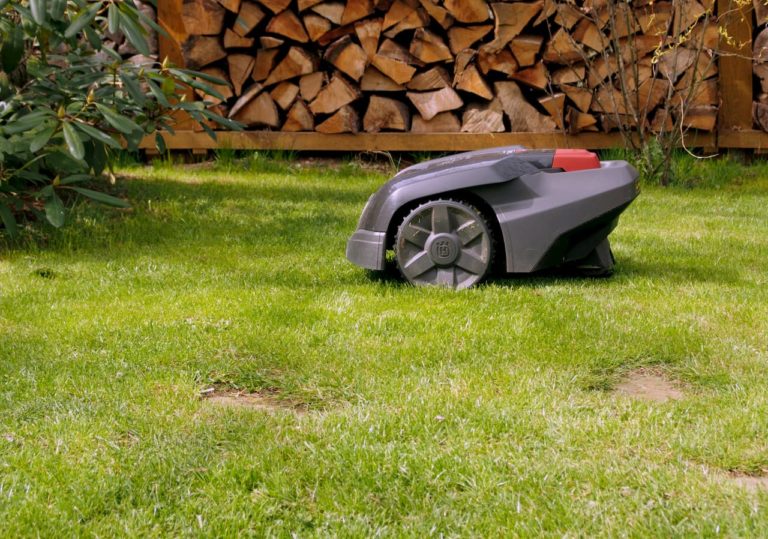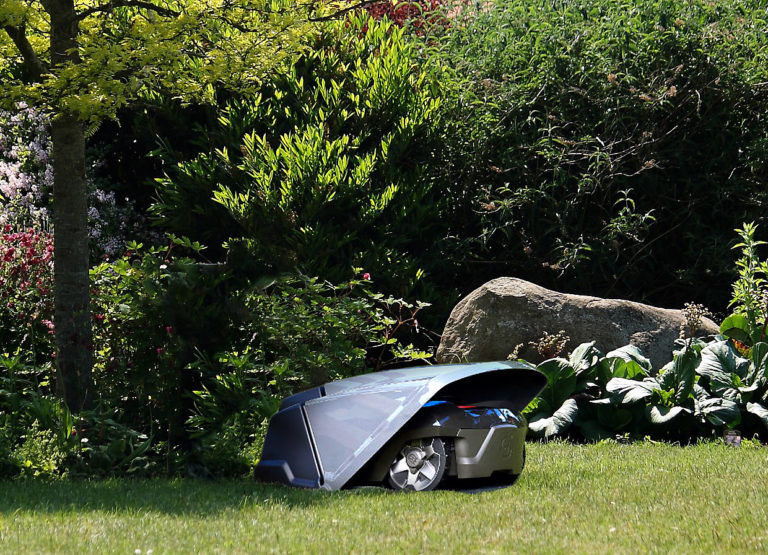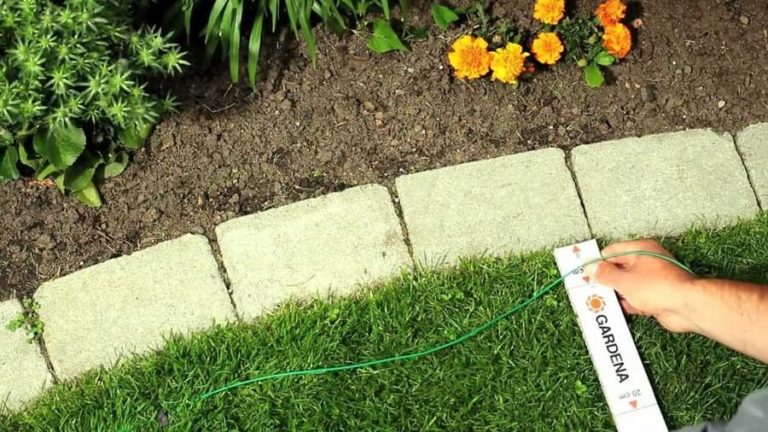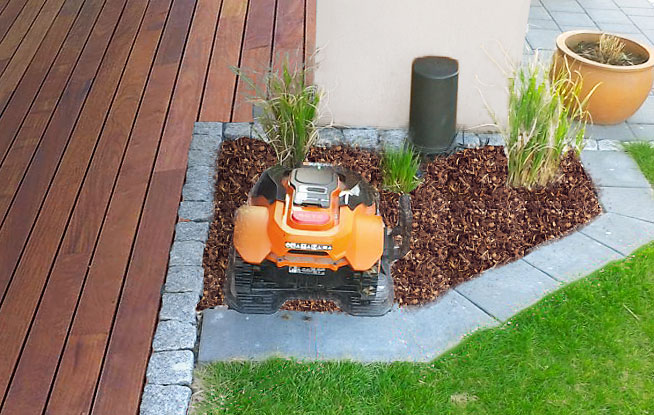Do you have a trampoline in your yard that your robotic mower is always getting hung up on? Or perhaps you didn’t even know that the two could clash, and you’re just here to get information before buying a robotic mower or trampoline? Here I’ll explain the problem to you and present a number of solutions.
What solutions are available for robotic mowers in yards with trampolines? In order to prevent the robotic mower from getting stuck on the bars of the trampoline legs, you can usually fit a board across the bottom crossbar of the legs so that the robotic mower cannot drive over the that lie on the ground. If a board doesn’t fit because of the trampoline’s shape, you may also use chicken wire.
But how exactly does this work and what other solutions are available? You can find out here.
Contents
This is why robotic mowers often have problems with trampolines
In general, it is a very good idea to use a robotic mower in yards with a trampoline. Because trampolines are too low to mow under with a normal lawn mower, this limits how much of your lawn you can actually reach with a traditional mower.
While too short for a traditional lawn mower, a trampoline stands high enough that the lawn underneath is very visible. It is not important to everyone that the lawn is perfectly mowed everywhere, especially under the trampoline. But if you are one of those people who are bothered by an unmown lawn under the trampoline, a robotic mower can definitely help you out.
This is because it gets under the trampoline easily and also manages to navigate out from under it; provided that it does not drive over the crossbars on the ground which connect the trampoline’s legs in pairs. If this happens, two problems can occur.
- The robotic mower can get stuck
- The blades of the robotic mower can be damaged by the metal bars
The crossbars are there to provide additional stability. But these bars are almost always at ground level and come in at least three different shapes (these are the ones I know):
- Ground level connections of two trampoline legs
- Ground level connections of two trampoline legs, which lift off the ground towards the middle and taper upwards
- Ground level connections, which additionally arch outwards
Surely your trampoline has one of these forms of crossbars. The problem is that these bars are at ground level, so the robotic mower can drive onto them. Sometimes it is unable to free itself from this position. However, it happens even more often that the blades of the robotic mower collide with the metal bars, which can cause severe damage to the blades and produce a very loud and disturbing noise.
This problem exists in each of the above mentioned trampoline designs. The variant that tapers towards the top is particularly problematic, as the robotic mower often pushes itself slightly upwards along the rod that runs diagonally upwards. In this case, it can no longer free itself from this position.
Fortunately, there are a variety of solutions to this problem, no matter what your trampoline is like. In the following I show you different solutions. I have roughly divided the solutions into two groups.
There are solutions that still allow the trampoline to be moved afterwards, while the solutions from the second section do not allow the trampoline to be moved afterwards. In the last part I will introduce you to a completely different alternative that you may not have thought of yet.
Solutions for mobile trampolines
Boards and zip ties
This is probably the most common solution, which is suitable for many trampolines and which I have come across most often on the internet. You use several boards or wooden strips for this. You have to cut them to the right size and then drill two holes in each of the left, right and bottom sides. You can then connect the whole thing to the trampoline’s legs with zip ties.
This video shows what the solution can look like in practice:
With this construction, the robotic mower always runs into the boards and thus cannot get stuck on the bars. Of course, you have to trim along the bars with a trimmer, because the robotic mower does not reach the very edge.
This is a practical solution for many trampolines. However, some trampolines have outwardly curved struts, as described above. This solution may not work with these round projections. But there is the next solution.
Advantages
- Very reliable and durable solution
- Trampoline remains mobile
Disadvantages
- Does not work on all trampolines with outward curved crossbars
Trampoline barrier for robotic mower
A solution that works in the same way as the boards & zip tie solution is a special trampoline barrier. These are simply special metal bars, the length of which can be adjusted and then attached to the leg of the trampoline with a clamp on the left and right side.
Here in this video you can see how exactly this works:
Unfortunately these trampoline barriers are still quite difficult to get, even in Europe. I have yet to find a seller in the US were they are sold. If you know someone who sells them, or if you are a dealer selling such barriers, please contact me.
Advantages
- Very reliable and durable solution
- Trampoline remains mobile
- Extremely fast installation
Disadvantages
- Does not work on all trampolines with outward curved crossbars
Chicken wire, pond liner, landscaping fabric for round bracing
If the bracing of your trampoline is cantilevered out and curved in such a way that the solution with the boards does not work, you can try one of these solutions. However, if the overhang is not so large, the previous solution with the boards may work as well, as this has already been confirmed by some users. This depends on how much the cross bracing is arched outwards.
For the solution to strongly outward curved bracing, you use chicken wire, which is a very tightly woven wire mesh. You can use some like this roll here at Amazon, for example.
This flexible mesh can be perfectly stretched around the round crossbars and then attached to the trampoline poles with zip ties. Instead of the chicken wire, you can also try a robust pond liner or landscaping fabric.
Advantages
- Works on almost all trampolines
Rubber sheathed steel cables with pointed struts
A simpler solution, which is much less expensive and can be implemented much more quickly, uses a rubber-coated steel cable. This is simply stretched from one of the legs to the other. In the middle, where the strut tapers to a point, the cabled is wrapped once or twice around the strut so that the cable does not give too much when the robotic mower drives against it.
Unfortunately, this solution only works with the type of trampoline that has such bracing. I do not own such a trampoline myself, so I do not have a suitable picture. If you want to know exactly what this type of trampoline looks like, then take a look at the cross-bracing of the feet on this trampoline at Amazon. On this kind of trampoline, this solution works very well.
Advantages
- Very fast and cost-effective solution
Disadvantages
- Only works on trampolines with upward curved or pointed cross bracing
An apple guard prevents the cross bracing from being driven over
A completely different solution does not involve any changes to the trampoline, but rather an adaptation to the robotic mower itself. This involves a so-called apple guard . This is a flexible thin plate, for example made of plastic, or a perforated plate, which is attached to the front of the robotic mower. It is actually intended to prevent fallen fruit, especially apples, from getting under the robotic mower. It then pushes them in front of it.
But it also works wonderfully to prevent the robotic mower from driving over the crossbars. Because of the apple guard, the distance at the front between the body and the ground is much smaller than usual (only this way the apples do not get under the robotic mower). This means that the robotic mower will hit the bars of the cross struts on the ground at the front and does not run over them.
The only problem that can occur is that the robotic mower drives onto the bracing in reverse, because the apple guard is only attached at the front. However, this would only happen if there were obstacles in the immediate vicinity of the trampoline which would cause the robotic mower to reverse in such a way.
In addition, with the apple guards that are currently available, you have to drill holes on the robotic mower, which may result in a loss of warranty.
In this example you can see how the perforated plate can be attached (it’s a German site, just scroll a bit down and you see the images). You can find such perforated plates here at Amazon or in various hardware stores.
Advantages
- Works with a lot of different trampolines
- No complex installations on the trampoline necessary
Disadvantages
- Modification to the robotic mower is necessary, which can lead to loss of warranty (inform the dealer)
Solutions for fixed trampolines
If your trampoline does not necessarily have to be mobile and you don’t see yourself ever moving it, for example because you want to use the lawn for other purposes, then there are a few more solutions that I would like to introduce to you briefly here
Sink the trampoline into the ground a little
A solution that differs significantly from the above solutions is to sink the trampoline a little into the ground so that the robotic mower can drive over the cross bars. To do this, you should think carefully about where you want to place the trampoline, as it will then of course not be so easy to move it.
Then you first remove the turf in the appropriate places. It is best to use a lawn edger for this. If you do not have one, a spade will do. You should then use a long metal spatula or a bread knife to separate the turf from the ground. Then you have to dig about 10 inches deep into the ground with a trowel or shovel.
Now you can set the trampoline into the recess, fill it with earth again and put the grass bricks back on top. Press them down nicely. Since you have practically “replanted” the grass and it is not so well rooted anymore, you will now have to water it again thoroughly. In the coming weeks, especially in dry weather, the areas you dug up should be watered thoroughly and regularly until the lawn is well rooted again.
The following video shows the whole construction project in practice:
Advantages
- A robotic mower can mow above the crossbars. The grass only needs to be trimmed directly around where the vertical legs disappear into the ground.
- Trampoline stands more stable and cannot tip over as easily, even in strong winds
Disadvantages
- The trampoline can no longer be moved easily
Exclude with the boundary wire
The solution that I am presenting to you now, just like the previous solution, leads to the trampoline no longer being mobile. Here you use the boundary wire to block off the crossbars of the trampoline. With the boundary wire you can fortunately create “islands”, for example to exclude individual trees, bushes or other obstacles on the lawn.
You can also use this to exclude the respective pairs of legs that are braced together. You can read how to create islands with the boundary wire here.
The following diagram shows what the cable routing must look like.
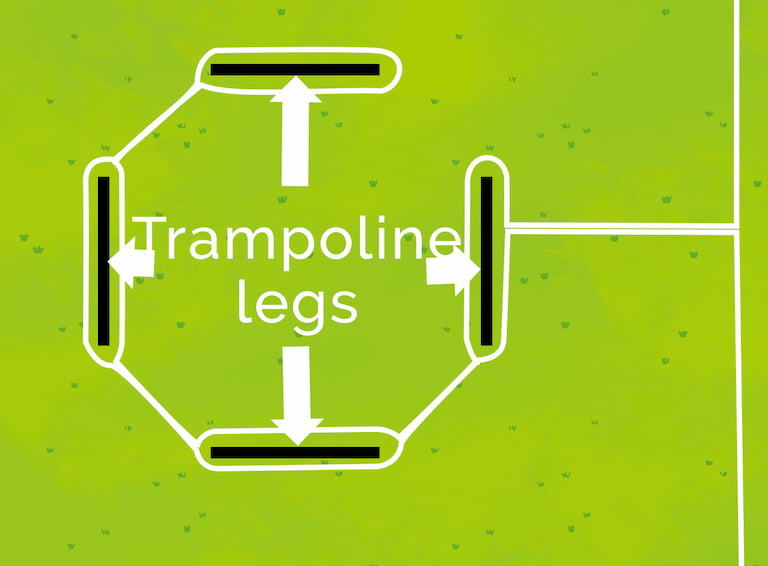
In principle it is a chain of several small islands. At the connections of the different islands you have to make sure that the cables leading in and out are as close as possible, but do not cross each other.
Advantages
- The robotic mower does not hit the trampoline directly. This protects the mower’s body, and there is less noise when mowing under the trampoline.
- The robotic mower mows a little more efficiently.
Disadvantages
- If the trampoline is moved, the exclusion is useless.
A completely different solution – the In-Ground trampoline
Here I present you a completely different solution, in case you have not yet purchased your trampoline. What if the lawn under the trampoline does not have to be mowed at all, simply because there is no “underneath”?
So-called In-Ground trampolines do not stand on stilts, but are sunk directly into the ground. They are available with or without a net, which has the additional advantage that they do not take up so much of the garden visually.
Here are some examples at eBay of such an In-Ground trampoline. Be aware that they seem to be only shipped from the EU. I haven’t found any US retailer for this yet (as of 2020). It might have changed since then, just make sure to check the shipping.
If you install an In-Ground trampoline, you will have to exclude such a trampoline with the boundary wire in any case, so that the robotic mower does not run over the trampoline and cut it up. Here again is the article about excluding islands.
Related questions
Can a robotic mower mow under swingsets? A robotic mower can also mow the lawn underneath a swing fairly well. Ideally, the feet of the swing are individually bounded with the boundary wire, even if this is not absolutely necessary. In order to avoid having to trim the edges of the swingset legs by hand, a short piece of artificial grass can be laid at these points.
How can obstacles be excluded with the boundary wire? To cut out obstacles with the boundary wire of the robotic mower, the boundary wire must bend from the edge towards the obstacle. There it runs around the obstacle and is then led back parallel to the cable at a distance of 0 inches. It must not cross over itself.
Also interesting: Creating islands for: Manual with graphics
